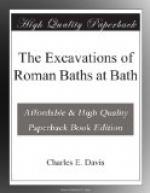All these fragments I have lately proved to be portions of the great Roman Bath (Plates VII. and VIII.), and being within instead of without that building. The Rev. Prebendary Scarth omits altogether to figure the southern rectangular exedra, found at the same time as the last named discovery. He also omits the discoveries made in 1809 (?) beneath the houses at the north-western end of York Street. In 1790 very valuable discoveries were made in digging the foundation of the present Pump Room. Many writers have treated of them and expressed opinions as to the character of the work and the meaning of the design, and Mr. Scharf, in Archaeologia, Vol. XXXVI., has done ample justice to these most interesting vestiges: They have been described by Pownall, Lysons, Warner, Collins, Scharf, Tite, and Scarth, as being portions of a Temple of the usual type, dedicated to Sul Minerva. Whitaker, in a review of Warner’s History of Bath, printed in the Anti-Jacobin, Vol. X., 1801, differs from all these writers, although believing the remains to be a portion of a temple, and thought they were a part of a building of the form of “a rotunda,” as the Pantheon. “The Pantheon of Minerva Medica, an agnomen very similar in allusiveness to our praenomen of Sulinis, for Minerva is noticed expressly by Ruius and Victor in their short notes concerning the structures of Rome, as then standing in the Esquiline quarter. The form of a Pantheon is made out by the multiplicity of niches,... and such, we believe, was our own Temple of Minerva at Bath.” It would occupy too much space were I to attempt to add to this paper my views of this discovery, but I may briefly say, that I am satisfied that they were not the remains of a Temple, but a portion of the central Portico and grand Vestibule of the Baths. I have not gone fully into the reasons that induced Whitaker to believe that the discoveries showed that the building was a Rotunda, but it is curious that he should have thought they had a similarity to the Pantheon at Rome, which antiquaries since his time have proved was not ’built for a temple, but that it was an entrance hall or vestibule of the Baths of Agrippa, although it is doubtful if the Rotunda was built at the same time as the Portico, which was, without doubt, erected B.C. 27.
The grand Roman enclosure of the Hot well (Pl. VII[12]) (which I have lately discovered and excavated, beneath the King’s Bath, on the south of this principal Portico) is again utilised, and forms a tank for the mineral water, from which are fed the baths and fountains with water, pure as it rises from “depths unknown,” and secured from any possibility of contamination in its passage, through the newly discovered water ducts and drains of the Romans.




